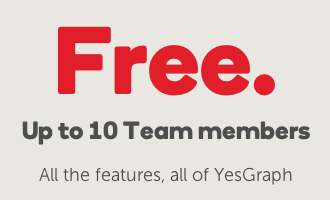
We recently distilled a mission for YesGraph, and I wanted to share the outcome and the process so that you can try it for your company.
For context, YesGraph has created a referral recruiting product that helps companies scale the most successful source of candidates, referrals. If you haven’t tried YesGraph yet, check it out, or get in touch for a demo.
The product is designed to be simple, and the steps involved are logical and easy to understand. You get your team to connect to Facebook or LinkedIn so we can organize and rank their contacts. This enables one-click referrals, which helps you scale that channel.
All that said, your product today isn’t your company’s mission.
You probably rightly focus on iterative improvements to make your product better. You listen to user feedback and run tests. Hopefully, you mercilessly cut that which isn’t going to help achieve your goal. But your current product and your near term road map are far too specific to make a great company mission. Especially for a startup, things change and evolve far too fast.
This isn’t bad. In fact, going through this process will help guide you to a place where you know enough to clarify your mission. Here’s how.
Isolate what won’t change about your company by abstracting away your immediate work. For YesGraph, the kernel within all our ideas is helping people perform better with good design and finding insight from data. This is sometimes surprisingly valuable with referrals, where we often illuminate parts of your network that didn’t come to mind.
To help refine your mission, start with adjacent ideas to what you’re building. YesGraph helps companies hire today, but what could we do to help job seekers? What if we built a way for people to find all the companies they are connected to, and how? Maybe we could be smart about how to get introduced to those companies. We’re seeing some interesting behavior elsewhere too, where some YesGraph users are generating sales leads through their network. Sales is really different from recruiting, and but the process we enable can be applied to both.
These ideas would take the company in a different direction. Explore where you’ll be over the very long term. What if we designed an applicant tracking system designed in the same fashion as YesGraph? We don’t plan on it, but over the long term, how would it be different? Or take peer review systems, which are clunky and don’t help employees grow and achieve their potential. One obvious improvement is to couple the data from performance reviews to your recruiting pipeline. It is a bit insane this isn’t easy or common already: the data about who does well at your company doesn’t inform how you hire more successful people.
To find your mission, combine your adjacent ideas and your longer term path, and extract what stays constant.
For YesGraph, we distilled our mission to this:
YesGraph connects people and companies with social data.
That’s it. It isn’t too fancy, and also not very precise. But if you understand our product and how we think about building it, you can clearly see the mission in our work. There are many other benefits, the most obvious is being able to convey our ideas clearly and succinctly.
Now it is your turn. I’d love to hear what people think about this process, and if you’ve come up with something valuable for yourself. Leave a comment here, or get in touch.








